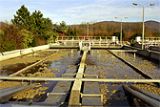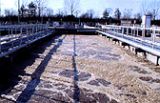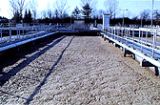In the digestion tower of the sewage treatment plant of the Abwasserzweckverband (AZV) Heidelberg, it began to foam during the cold season a few years ago - as is the case with numerous other sewage treatment plants. This led to considerable operational disturbances. The digestion towers were only foam-free for a few months.
Fraunhofer IGB discovered that filamentous microorganisms were causing the foam. The oxygen input into the supposedly anoxic denitrification zone was identified as the cause for the seasonal occurrence of the filamentous microorganisms. By taking suitable measures, the development of the filamentous organisms could be significantly reduced and thus the formation of foam could be decreased.
Preventing foam generation in the digestion tower of the sewage plant in Heidelberg
Conventional approach to foam control
The measures proposed in the literature to remedy this "floating sludge problem" range from the addition of precipitants (in some cases also two-substance dosing of polymer and iron salts), through mechanical foam destruction by crushing, to the proposal to remove the floating sludge by regular clearance. However, these are all measures that merely combat the symptoms.
Approach of the IGB
The aim of our approach was to find the causes and prevent foam formation. A careful analysis of the operating logs and a measuring program have shown that the foam formation is caused by the occurrence of filamentous growing microorganisms. They develop in the denitrification zone and activation and enter the digestion tower with the secondary sludge. There they are poorly degraded and hinder the gas discharge, so that the digested sludge acquires a foamy consistency and foaming over of the digestion towers can occur. The oxygen input in the supposed anoxic denitrification zone was identified as the cause for the growth of the filamentous microorganisms, as here the filamentous microorganisms compete with the floc-forming denitrifiers for the limiting substrate dissolved oxygen.
Oxygen input into the denitrification zone

Oxygen is introduced firstly via the surface of the denitrification zone, which is strongly agitated by stirring, secondly via the recirculation sludge (return sludge), as this is conveyed by a screw pump, and thirdly via the inlet to the sewage treatment plant, as the low temperatures in winter greatly reduce the oxygen consumption in the channels and at the same time increase the oxygen solubility.
Since the dissolved oxygen concentration in the denitrification tank is very low, the oxygen input contributes to a large extent to the growth of filamentous microorganisms, since these still grow even at low oxygen concentrations. In winter, when the temperature in the treatment plant is around 10 °C, more oxygen is introduced into the deninitrification zone due to the greater driving concentration gradient between air and water, so that the filamentous microorganisms multiply, especially in winter.
Measures

Various measures are conceivable to reduce the oxygen input into the denitrification zone:
- You can move the surface less.
(This was not realized because of the fear of sludge deposits).
- One can reduce the surface, e.g. by a floating blanket.
- One can reduce the floating concentration gradient, e.g. by enclosing the denitrification zone so that there is no longer any contact with the ambient air.
The operators of the Heidelberg wastewater treatment plant decided on an enclosure in the form of a wooden construction covering the denitrification zone of one of several parallel activated sludge roads (road 2) (Fig. 1). Later, the return sludge pump was also enclosed.
Results


Although the oxygen input in the Deni zone could only be reduced incompletely due to leaks, the floating sludge on the activation of road 2 was reduced considerably. Figure 2 shows the almost foam-free activation of road 2 at the top, while the thick foam-covered activation of one of the other roads is shown below.
An unexpected but important result of the measuring program was the realization that a large part of the denitrification already takes place in the secondary clarification. The return sludge contains relatively little nitrate-N (approx. 1 mg/l), while the effluent values of the final sedimentation into the receiving waters are about 4 to 8 mg/l. This means that the floc-forming denitrificants in the denitrification zone are poorly supplied with nitrate-oxygen - another advantage for the filamentous microorganisms.
With the help of a computer simulation, the influence of various factors on the composition of the microorganism population could be shown for a model sewage treatment plant with upstream denitrification zone. In the warm season (lower oxygen input) the filamentous organisms decrease and the population of flocculants increases accordingly, in the cold season (increased oxygen input) the opposite is true. The model shows that floating and bulking sludge problems do not occur until several years after the denitrification zone has been commissioned. This has been confirmed by many operators of municipal sewage treatment plants.
Summary
The seasonal occurrence of filamentous microorganisms in modern, extended wastewater treatment plants is closely linked to the oxygen input into the supposedly anoxic denitrification zone. Based on the results presented, it could be shown that measures can be taken on the basis of this knowledge, which clearly influence the development of the filamentous microorganisms. Thus, a contribution to the reduction of this floating and bulking sludge problem can be made in the future.
 Fraunhofer Institute for Interfacial Engineering and Biotechnology IGB
Fraunhofer Institute for Interfacial Engineering and Biotechnology IGB